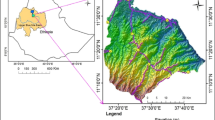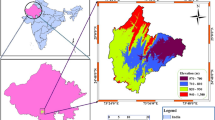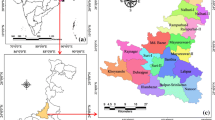Abstract
Locating potential zones of ground water reservoir is a challenging task particularly in dry areas, mountaneous region or lateritic zones. In the present century, Satellite Remote sensing could offer a fresh promise to identify surface and sub-surface water resources with less time and cost. The present study was carried out in the drought-prone red and lateritic zones (RLZs) of West Bengal, India, to identify groundwater potential zones. Multi-criteria approach based on remote sensing and geographic information system utilizing six parameters, namely hydrogeomorphology, slope, drainage density, lineaments density, land use/land cover and fractional impervious surface were used in this analysis. Weightages were assigned to the parameters using Analytical Hierarchical Process (AHP) while different classes within each parameter were ranked according to their relative importance for groundwater potentiality. The study characterized different zones of groundwater prospects, viz. excellent (0.77%), good (35.20%), fair (61.80%), and poor (2.13%). During validation, 81% among the surveyed 180 dug wells of the area in the “good” potential zones were found to be perennial; while, ten among the ten dug wells surveyed in the ‘poor’ potential zone were found to be non-perennial in nature. The findings, thus, could establish that present methodology using AHP with enhanced parameterization has a better potential to identify and map the groundwater potential zones more realistically, and can be applied for drought risk reduction in wider RLZ zones.









Similar content being viewed by others
References
Abdalla F (2012) Map** of groundwater prospective zones using remote sensing and GIS techniques: a case study from the Central Eastern Desert, Egypt. J Afr Earth Sci 70:8–17
Adiat KAN, Nawawi MNM, Abdullah K (2012) Assessing the accuracy of GIS-based elementary multi-criteria decision analysis as a spatial prediction tool—a case of predicting potential zones of sustainable groundwater resources. J Hydrol 440:75–89
Agarwal R, Garg PK (2016) Remote sensing and GIS based groundwater potential & recharge zones map** using multi-criteria decision making technique. Water Resour Manag 30(1):243–260
Agarwal E, Agarwal R, Garg RD, Garg PK (2013) Delineation of groundwater potential zone: an AHP/ANP approach. J Earth Syst Sci 122(3):887–898
Al-Abadi AM (2015) Groundwater potential map** at northeastern Wasit and Missan governorates, Iraq using a data-driven weights of evidence technique in framework of GIS. Environ Earth Sci 74(2):1109–1124
Asadi SS, Vuppala P, Reddy MA (2007) Remote sensing and GIS techniques for evaluation of groundwater quality in municipal corporation of Hyderabad (Zone-V), India. Int J Environ Res Public Health 4(1):45–52
Bhunia GS, Samanta S, Pal DK, Pal B (2012) Assessment of groundwater potential zone in Paschim Medinipur District, West Bengal—a mesoscale study using GIS and remote sensing approach. J Environ Earth Sci 2(5):41–59
Brun SE, Band LE (2000) Simulating runoff behavior in an urbanizing watershed. Comput Environ Urban Syst 24(1):5–22
Butler M, Wallace J, Lowe M (2002) Groundwater quality classification using GIS contouring methods for cedar valley, Iron County, Utah. Digit Mapp Tech 2002:207
Carlson TN, Ripley DA (1997) On the relation between NDVI, fractional vegetation cover, and leaf area index. Remote Sens Environ 62(3):241–252
Chandra S, Rao VA, Krishnamurthy NS, Dutta S, Ahmed S (2006) Integrated studies for characterization of lineaments used to locate groundwater potential zones in a hard rock region of Karnataka, India. Hydrogeol J 14(6):1042–1051
Chenini I, Mammou AB, El May M (2010) Groundwater recharge zone map** using GIS-based multi-criteria analysis: a case study in Central Tunisia (Maknassy Basin). Water Resour Manag 24(5):921–939
Das S, Behera SC, Kar A, Narendra P, Guha S (1997) Hydrogeomorphological map** in groundwater exploration using remotely sensed data—a case study in keonjhar district, orissa. J Ind Soc Remote Sens 25(4):247–259
Devi SP, Srinivasulu S, Raju KK (2001) Delineation of groundwater potential zones and electrical resistivity studies for groundwater exploration. Environ Geol 40(10):1252–1264
Dinesh Kumar PK, Gopinath G, Seralathan P (2007) Application of remote sensing and GIS for the demarcation of groundwater potential zones of a river basin in Kerala, southwest coast of India. Int J Remote Sens 28(24):5583–5601
Ferozu RM, Jahan CS, Arefin R, Mazumder QH (2019) Groundwater potentiality study in drought prone barind tract, NW Bangladesh using remote sensing and GIS. Groundw Sustain Dev 8:205–215
Fohrer N, Haverkamp S, Eckhardt K, Frede HG (2001) Hydrologic response to land-use changes on the catchment scale. Phys Chem Earth Part B 26(7–8):577–582
Ghosh PK, Jana NC (2017) Groundwater potentiality of the Kumari River Basin in drought-prone Purulia upland, Eastern India: a combined approach using quantitative geomorphology and GIS. Sustain Water Resour Manag 4(3):583–599
Gumma MK, Pavelic P (2013) Map** of groundwater potential zones across Ghana using remote sensing, geographic information systems, and spatial modeling. Environ Monit Assess 185(4):3561–3579
Guru B, Seshan K, Bera S (2017) Frequency ratio model for groundwater potential map** and its sustainable management in cold desert, India. J King Saud Univ Sci 29(3):333–347
Hardcastle KC (1995) Photolineament factor: a new computer-aided method for remotely sensing the degree to which bedrock is fractured. Photogramm Eng Remote Sens 61(6):739–746
Horton RE (1945) Erosional development of streams and their drainage basins; hydrophysical approach to quantitative morphology. Geol Soc Am Bull 56(3):275–370
Ibrahim-Bathis K, Ahmed SA (2016) Geospatial technology for delineating groundwater potential zones in Doddahalla watershed of Chitradurga district, India. Egypt J Remote Sens Space Sci 19(2):223–234
Ishizaka A, Labib A (2011) Review of the main developments in the analytic hierarchy process. Expert Syst Appl 38:14336–14345
Jaiswal RK, Mukherjee S, Krishnamurthy J, Saxena R (2003) Role of remote sensing and GIS techniques for generation of groundwater prospect zones towards rural development—an approach. Int J Remote Sens 24(5):993–1008
Jasrotia AS, Kumar A, Singh R (2016) Integrated remote sensing and GIS approach for delineation of groundwater potential zones using aquifer parameters in Devak and Rui watershed of Jammu and Kashmir, India. Arab J Geosci 9(4):304
Kaliraj S, Chandrasekar N, Magesh NS (2014) Identification of potential groundwater recharge zones in Vaigai upper basin, Tamil Nadu, using GIS-based analytical hierarchical process (AHP) technique. Arab J Geosci 7(4):1385–1401
Kasperson RE (2015) Risk governance and the social amplification of risk: a commentary. In: Risk governance. Springer, Dordrecht, pp 485–487
Krishnamurthy J, Venkatesa Kumar N, Jayaraman V, Manivel M (1996) An approach to demarcate ground water potential zones through remote sensing and a geographical information system. Int J Remote Sens 17(10):1867–1884
Kumar MG, Agarwal AK, Bali R (2008) Delineation of potential sites for water harvesting structures using remote sensing and GIS. J Indian Soc Remote Sens 36(4):323–334
Leduc C, Favreau G, Schroeter P (2001) Long-term rise in a Sahelian water-table: the Continental Terminal in south-west Niger. J Hydrol 243(1–2):43–54
Lee JG, Heaney JP (2003) Estimation of urban imperviousness and its impacts on stormwater systems. J Water Resourc Plan Manag 129(5):419–426
Machiwal D, Jha MK, Mal BC (2011) Assessment of groundwater potential in a semi-arid region of India using remote sensing, GIS and MCDM techniques. Water Resour Manag 25(5):1359–1386
Madrucci V, Taioli F, de Araújo CC (2008) Groundwater favorability map using GIS multicriteria data analysis on crystalline terrain, Sao Paulo State, Brazil. J Hydrol 357(3–4):153–173
Magesh NS, Chandrasekar N, Soundranayagam JP (2012) Delineation of groundwater potential zones in Theni district, Tamil Nadu, using remote sensing, GIS and MIF techniques. Geosci Front 3(2):189–196
Magowe M, Carr JR (1999) Relationship between lineaments and groundwater occurrence in western Botswana. Groundwater 37(2):282–286
Maity DK, Mandal S (2017) Identification of groundwater potential zones of the Kumari river basin, India: an RS & GIS based semi-quantitative approach. Environ Dev Sustain. https://doi.org/10.1007/s10668-017-0072-0
Mallick J, Singh CK, Al-Wadi H, Ahmed M, Rahman A, Shashtri S, Mukherjee S (2015) Geospatial and geostatistical approach for groundwater potential zone delineation. Hydrol Process 29(3):395–418
Manap MA, Sulaiman WNA, Ramli MF, Pradhan B, Surip N (2013) A knowledge-driven GIS modeling technique for groundwater potential map** at the Upper Langat Basin, Malaysia. Arab J Geosci 6(5):1621–1637
Milly PCD (1994) Climate, soil water storage, and the average annual water balance. Water Resour Res 30(7):2143–2156
Milly PCD, Dunne KA (1994) Sensitivity of the global water cycle to the water-holding capacity of land. J Clim 7(4):506–526
Mukherjee A, Banerjee S (2009) Rainfall and temperature trend analysis in the red and lateritic zone of West Bengal. J Agrometeorol 11(2):196–200
Mukherjee A, Patil D (2013) Appraisal of Use Pattern in Wetalnds of Bankura, a drought prone region from eastern India. J Appl Technol Environ Sanit 3(4):141–146
Mukherjee P, Singh CK, Mukherjee S (2012) Delineation of groundwater potential zones in arid region of India—a remote sensing and GIS approach. Water Resour Manag 26(9):2643–2672
Murasingh S (2014) Analysis of groundwater potential zones using electrical resistivity, rs & gis techniques in a typical mine area of Odisha (Doctoral dissertation)
Nag SK (1998) Morphometric analysis using remote sensing techniques in the Chaka sub-basin, Purulia district, West Bengal. J Indian Soc Remote Sens 26(1–2):69–76
Nag SK (2005) Application of lineament density and hydrogeomorphology to delineate groundwater potential zones of Baghmundi block in Purulia district, West Bengal. J Indian Soc Remote Sens 33(4):521
Nag SK, Ghosh P (2012) Delineation of groundwater potential zone in Chhatna Block, Bankura District, West Bengal, India using remote sensing and GIS techniques. Environ Earth Sci 70(5):2115–2127
Nag SK, Kundu A (2016) Application of remote sensing, GIS and MCA techniques for delineating groundwater prospect zones in Kashipur block, Purulia district, West Bengal. Appl Water Sci 8(1):38
Nag SK, Lahiri A (2011) Integrated approach using Remote Sensing and GIS techniques for delineating groundwater potential zones in Dwarakeswar watershed, Bankura district, West Bengal. Int J Geomat Geosci 2(2):430
Nagarajan M, Singh S (2009) Assessment of groundwater potential zones using GIS technique. J Indian Soc Remote Sens 37(1):69–77
Naghibi SA, Pourghasemi HR, Dixon B (2016) GIS-based groundwater potential map** using boosted regression tree, classification and regression tree, and random forest machine learning models in Iran. Environ Monit Assess 188(1):44
Ndatuwong LG, Yadav GS (2014) Integration of hydrogeological factors for identification of groundwater potential zones using remote sensing and GIS techniques. J Geosci Geomat 2(1):11–16
Nsiah E, Appiah-Adjei EK, Adjei KA (2018) Hydrogeological delineation of groundwater potential zones in the Nabogo basin, Ghana. J Afr Earth Sc 143:1–9
Owen SM, Boissard C, Hagenlocher B, Hewitt CN (1998) Field studies of isoprene emissions from vegetation in the Northwest Mediterranean region. J Geophys Res-Atmos 103(D19):25499–25511
Patra S, Mishra P, Mahapatra SC (2018) Delineation of groundwater potential zone for sustainable development: a case study from Ganga Alluvial Plain covering Hooghly district of India using remote sensing, geographic information system and analytic hierarchy process. J Clean Prod 172:2485–2502
Pourtaghi ZS, Pourghasemi HR (2014) GIS-based groundwater spring potential assessment and map** in the Birjand Township, southern Khorasan Province, Iran. Hydrogeol J 22(3):643–662
Prasad RK, Mondal NC, Banerjee P, Nandakumar MV, Singh VS (2008) Deciphering potential groundwater zone in the hard rock through the application of GIS. Environ Geol 55(3):467–475
Rahman MA, Rusteberg B, Gogu RC, Ferreira JL, Sauter M (2012) A new spatial multi-criteria decision support tool for site selection for implementation of managed aquifer recharge. J Environ Manag 99:61–75
Rahmati O, Samani AN, Mahdavi M, Pourghasemi HR, Zeinivand H (2015) Groundwater potential map** at Kurdistan region of Iran using analytic hierarchy process and GIS. Arab J Geosci 8(9):7059–7071
Rajaveni SP, Brindha K, Elango L (2017) Geological and geomorphological controls on groundwater occurrence in a hard rock region. Appl Water Sci 7(3):1377–1389
Rao NS, Chakradhar GKJ, Srinivas V (2001) Identification of groundwater potential zones using remote sensing techniques in and around Guntur town, Andhra Pradesh, India. J Indian Soc Remote Sens 29(1–2):69
Ray A (1982) Indus trial potential of Purulia West Bengal A study in Economic Geography (Ph.D. thesis)
Reddy PR, Kumar KV, Seshadri K (1996) Use of IRS-1C data in groundwater studies. Curr Sci 70:600–605
Ridd MK (1995) Exploring a VIS (vegetation-impervious surface-soil) model for urban ecosystem analysis through remote sensing: comparative anatomy for cities. Int J Remote Sens 16(12):2165–2185
Roscoe Moss Company (1990) Handbook of groundwater development. Wiley, Hoboken
Saraf AK, Choudhury PR (1998) Integrated remote sensing and GIS for groundwater exploration and identification of artificial recharge sites. Int J Remote Sens 19(10):1825–1841
Sehgal J (1998) Red and lateritic soils: an overview. Red Lateritic Soils 1:3–10
Sener E, Davraz A, Ozcelik M (2005) Integration of GIS and remote sensing in groundwater investigations: a case study in Burdur, Turkey. Hydrogeol J 13(5–6):826–834
Singh LK, Jha MK, Chowdary VM (2018) Assessing the accuracy of GIS-based multi-criteria decision analysis approaches for map** groundwater potential. Ecol Ind 91:4–37
Singh SK, Zeddies M, Shankar U, Griffiths GA (2019) Potential groundwater recharge zones within New Zealand. Geosci Front. https://doi.org/10.1016/j.gsf.2018.05.018
Taylor RG, Scanlon B, Doll P, Rodell M, Van Beek R, Wada Y, Longuevergne L, Leblanc M, Famiglietti JS, Edmunds M, Konikow L (2013) Groundwater and climate change. Nat Clim Change 3(4):322–329
Thapa R, Gupta S, Guin S, Kaur H (2017) Assessment of groundwater potential zones using multi-influencing factor (MIF) and GIS: a case study from Birbhum district, West Bengal. Appl Water Sci 7(7):4117–4131
Todd DK (1980) Groundwater hydrology, 2nd edn. Wiley, New York, pp 111–163
Waikar ML, Nilawar AP (2014) Identification of groundwater potential zone using remote sensing and GIS technique. Int J Innov Res Sci Eng Technol 3(5):12163–12174
Weng Q (2012) Remote sensing of impervious surfaces in the urban areas: requirements, methods, and trends. Remote Sens Environ 117:34–49
Yammani S (2007) Groundwater quality suitable zones identification: application of GIS, Chittoor area, Andhra Pradesh, India. Environ Geol 53(1):201–210
Yeh HF, Cheng YS, Lin HI, Lee CH (2016) Map** groundwater recharge potential zone using a GIS approach in Hualian River, Taiwan. Sustain Environ Res 26(1):33–43
Zhou Y, Wang Y, Gold AJ, August PV (2010) Modeling watershed rainfall-runoff relations using impervious surface-area data with high spatial resolution. Hydrogeol J 18(6):1413–1423
Acknowledgements
The study was sponsored by the National Bank for Agriculture and Rural Development, India (NABARD) through the Development Research Communication and Services Centre (DRCSC), Kolkata from the Climate Adaptation Fund (AFB/PPRC15/12). The authors are grateful for these financial and logistic supports. The authors also express their gratitude to the Geological Survey of India and Survey of India for providing the secondary data. The author (S. Roy) is thankful to Jadavpur University, India for providing the State Fellowship.
Author information
Authors and Affiliations
Corresponding author
Additional information
Publisher's Note
Springer Nature remains neutral with regard to jurisdictional claims in published maps and institutional affiliations.
Electronic supplementary material
Below is the link to the electronic supplementary material.
Rights and permissions
About this article
Cite this article
Roy, S., Hazra, S., Chanda, A. et al. Assessment of groundwater potential zones using multi-criteria decision-making technique: a micro-level case study from red and lateritic zone (RLZ) of West Bengal, India. Sustain. Water Resour. Manag. 6, 4 (2020). https://doi.org/10.1007/s40899-020-00373-z
Received:
Accepted:
Published:
DOI: https://doi.org/10.1007/s40899-020-00373-z




